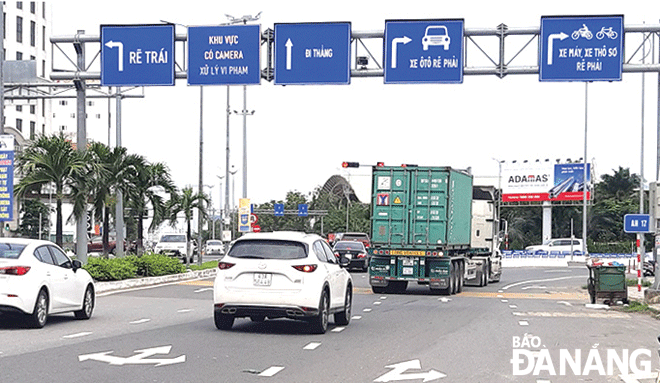Da Nang gears up development of intelligent transport system
In order to meet the future transportation development needs, Da Nang’s transport sector has significantly promoted proper and creative approaches, one of which is to develop its own intelligent transport system (ITS).
 |
| The surveillance camera system at the western end of the Tien Son Bridge has just been put into use, contributing to reducing traffic accidents. Photo: THANH LAN |
Amid the fact that traffic infrastructure cannot keep up with the rapidly increasing vehicle density, Da Nang has promoted the development of ITS to solve challenges arising by urban development strides.
According to architect Tran Dan, Vice Chairman of the Da Nang Bridge and Road Association, the ITS model has been successfully deployed in many countries around the world. Vietnamese localities, and Da Nang in particular, with the current human potential, have also gained some initial encouraging results from the application of ITS.
Since 2012, the city's transport industry has taken the first step towards ITS with the establishment of traffic lights at 64 traffic intersections, 32 cameras, one meteorological monitoring station and one traffic control centre.
Up to now, the intersection equipped with traffic lights has increased to 181, of which 62 are connected to the municipal Traffic Signal and Public Transport Operation Centre.
It is known that, at present, the city is installing a system which monitor structure, temperature and wind at the Rong (Dragon) and Tran Thi Ly bridges to serve the management, maintenance and warning of tourist boats. Previously, such systems had been installed at the Thuan Phuoc Bridge, a section of the Tran Thi Ly Bridge and the Hue T-junction overpass.
In addition, the city has put into use 177 on-street surveillance cameras to detect and handle traffic violations, 16 speed measurement devices, and surveillance cameras onboard 151 buses operating on 12 subsidized intra- city bus route and 26 cameras onboard tourist boats travelling on the iconic Han River.
In particular, CCTV and surveillance systems are being developed with new functions including vehicle and people counting with the use of artificial intelligence (AI).
In the field of transport, a combined total of 13,000 vehicles with more than nine seats and trucks have had in-cabin surveillance cameras installed.
Recording and storage of the images on the vehicles must be sent to police, traffic inspectors and licensing agencies to ensure transparent surveillance. Videos and images must be transmitted 12-20 times per hour on journeys to transportation businesses and the DRVN.
The installation of surveillance cameras in road transport vehicles aims to improve the effectiveness of transport management, contributing to preventing and minimising traffic accidents.
Besides, the city piloted the smart collection of park fees from vehicles parked along Bach Dang and Tran Phu, two of the largest streets in the Da Nang centre. The service allows commuters to pay parking fees through their smart phones or (SMS). Fees for each parking place cost from VND15,000 to VND30,000 for two hours.
In June 2017, the city and Toyota Mobility Foundation (TMF) jointly launched a new public shuttle bus route costing US$2.9 million to help prevent traffic congestion. The TMF bus station is located on Bui Duong Lich Street.
Notably, Da Nang’s first-ever automated parking garage was officially put into operation in 2019 at 255 Phan Chau Trinh, Hai Chau District.
The Department of Transport has also deployed a specialised integrated database to ensure efficient storage and exploitation of areas such as infrastructure (traffic signal systems, toll stations), means (types, characteristics, levels of use) and operator (behavior, movement) in order to create a foundation for digital transformation and develop ITS in the future.
Reporting by THANH LAN – Translating by A. THU